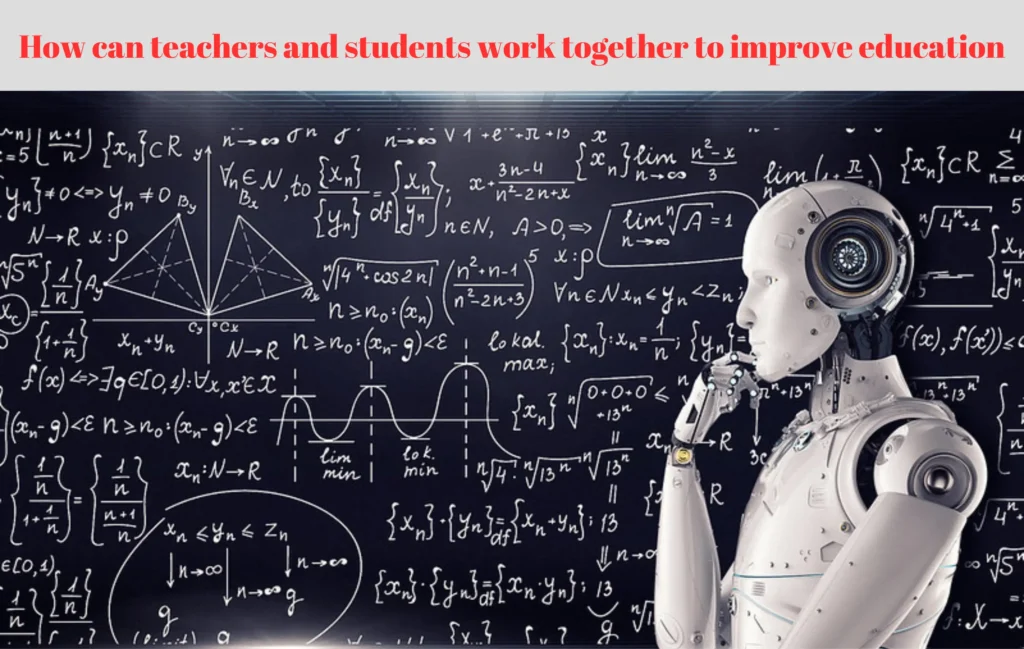How can teachers and students work together to improve education
Teachers and students can collaborate in various ways to enhance education:
Open Communication:
Establishing open lines of communication where students feel comfortable expressing their needs and concerns fosters a supportive learning environment. Teachers can encourage feedback and suggestions from students about teaching methods, assignments, and classroom activities.
Student-Centered Learning:
Incorporate student interests and preferences into the curriculum whenever possible. This could involve allowing students to choose topics for projects or offering alternative assignment options that cater to different learning styles.
Collaborative Projects:
Encourage teamwork and collaboration among students on projects and assignments. This not only enhances their interpersonal skills but also allows them to learn from each other’s strengths and perspectives.
Feedback Mechanisms:
Implement regular feedback mechanisms such as surveys or class discussions to gather insights from students about what is working well and what can be improved in the classroom. Teachers can use this feedback to adapt their teaching methods accordingly.
Co-Creation of Learning Materials:
Involve students in the creation of learning materials, such as designing study guides or developing multimedia presentations. This not only engages students more deeply in the learning process but also empowers them to take ownership of their education.
Peer Teaching and Mentoring:
Encourage peer teaching and mentoring where more advanced students can help their peers who may be struggling with certain concepts. This not only reinforces the learning for the student teaching but also provides valuable support to their classmates.
Use of Technology:
Utilize technology to facilitate collaboration and communication both inside and outside the classroom. Platforms like online discussion forums, collaborative document editing tools, and educational apps can enable students and teachers to interact and share resources more effectively.
Real-World Applications:
Connect classroom learning to real-world applications to make the material more relevant and engaging for students. This could involve guest speakers, field trips, or hands-on activities that demonstrate how the concepts they are learning are applied in the real world.

Professional Development:
Provide opportunities for teachers to engage in professional development focused on student collaboration and engagement strategies. Equipping teachers with the necessary skills and knowledge to effectively facilitate student involvement in the learning process is crucial for success.
Importance of teachers and students work together to improve education
Collaboration between teachers and students is essential for several reasons:
Enhanced Learning Experience: When teachers and students work together, they create a more engaging and interactive learning environment. Students feel more motivated and invested in their education when they have a voice in the learning process, leading to better retention and understanding of the material.
Tailored Instruction: Collaboration allows teachers to better understand the needs, interests, and learning styles of their students. With this insight, teachers can tailor their instruction to meet the individual needs of students, ensuring that each student has the opportunity to succeed.
Promotion of Critical Thinking: When students are actively involved in the learning process, they are encouraged to think critically and creatively. Collaboration fosters discussions, debates, and problem-solving activities that challenge students to think beyond rote memorization and develop higher-order thinking skills.
Empowerment and Ownership: Involving students in decision-making processes empowers them to take ownership of their education. When students feel that their voices are heard and respected, they are more likely to take initiative, set goals, and actively participate in their own learning journey.
Building Relationships: Collaboration between teachers and students strengthens the teacher-student relationship, creating a sense of trust and mutual respect. This positive relationship fosters a supportive learning environment where students feel comfortable asking questions, seeking help, and taking risks in their learning.
Promotion of Social and Emotional Skills: Collaborative learning experiences promote the development of important social and emotional skills such as communication, teamwork, empathy, and leadership. These skills are essential for success in both academic and real-world settings.
Continuous Improvement: By working together, teachers and students can identify areas for improvement and implement strategies to enhance the learning experience. This ongoing feedback loop ensures that education remains dynamic and responsive to the evolving needs of students.
FAQ
Here are some frequently asked questions related to the topic “How can teachers and students work together to improve education?
Why is collaboration between teachers and students important?
Collaboration promotes a more engaging learning environment, tailored instruction, critical thinking skills, empowerment, and positive relationships, among other benefits.
How can teachers encourage collaboration with students?
Teachers can encourage collaboration by fostering open communication, incorporating student interests into the curriculum, promoting teamwork on projects, and seeking student feedback.
What are some examples of collaborative activities for teachers and students?
Examples include collaborative projects, peer teaching, group discussions, student-led presentations, and co-creation of learning materials.
How can technology facilitate collaboration in education?
Technology can facilitate collaboration through online platforms for communication and document sharing, virtual collaboration tools, educational apps, and multimedia resources.
What are the benefits of peer teaching and mentoring?
Peer teaching and mentoring promote deeper understanding of concepts, reinforce learning for both the student teaching and the student being taught, and foster leadership and interpersonal skills.
How can collaboration between teachers and students improve student engagement?
Collaboration enhances student engagement by making learning more relevant, interactive, and student-centered, leading to increased motivation and participation.
What role does feedback play in collaboration between teachers and students?
Feedback is crucial for identifying areas for improvement, adjusting teaching methods, and fostering continuous growth and learning for both teachers and students.

